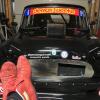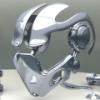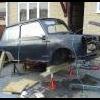If a fairly new Mk.1 Cooper or Cooper 'S' had a big accident early in its life and needed a new shell, the shell was just a part number to be ordered from a BMC dealer by the authorised repairer. There was no 'Cooper 'S' shell. The repairer had to transfer the various parts from the damaged shell, For example, the front panel diagonal support was cut off and welded into the new shell. The extra fuel tank fittings were originally part of a kit which could be bought as a package from BMC. In 1966 the twin tanks became standard on the 1275 'S'.
The oil cooler as mounted on the front panel was never standard and a kit was available, again from BMC dealers against a BMC part number.
The boot board brackets could be bought as could the boot board. They were also just BMC part numbers.
Once a crashed 'S', or even a 998 Cooper, had been repaired by an insurance company approved repairer, there was really no-way that a re-shell was detectable, not that anyone was particularly bothered. If I had crashed my 6-month old Cooper 'S' and my insurer decided to re-shell it why would I care. Re-shelling was so easy back then as the electronics systems were not an issue and it was a quick & simple job to transfer everything into a new shell.
I think it is impossible to define what is a genuine or a non-genuine Cooper or Cooper 'S' if it has the correct engine, running gear and trim.
What one needs to be careful of is a Mk.1 with Metro 1275 engine, 8.4" brakes and an incorrect interior trim, but with an apparently correct V5 registration document.
What I would do if buying an early 'S', is first of all to check the V5 for the numbers and listed engine. Then I would confirm the engine as a real 'S' block. After that I would check the other 'S' parts, which we have mentioned, as being correctly fitted. But even then the car could be genuine and not quite appear so. For example, if it had needed a new front panel and wings, the front panel might have the vertical support channel. If it had needed a new boot lid surround and rear floor, the boot board brackets might not now be fitted, or might be fitted incorrectly.
After over 50 years there is just no way to know for sure.


















